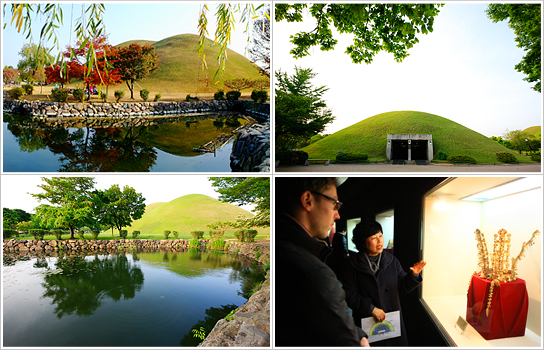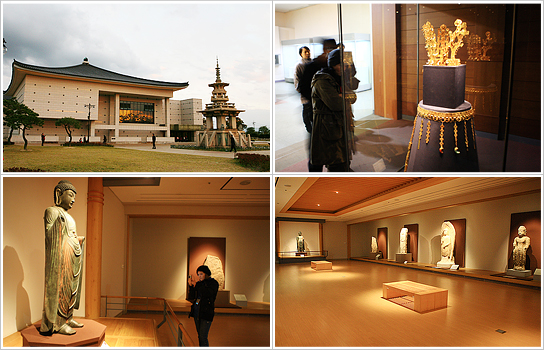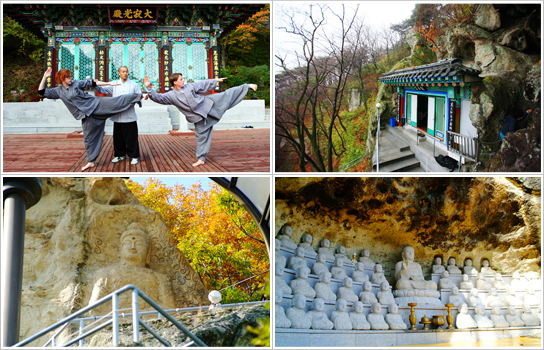Gyeongju City Tour

The City of Gyeongju is located in southeast Korea and has an important and rich history. For centuries, the city served as the capital of the Silla Dynasty (57-935 BC), the longest period of reign in the history of Korea. Even today, you'll find ancient landmarks blanketing the city, standing as proud testaments to a bygone era. These ancient relics are such an integral part of the landscape that the whole city has been designated a UNESCO World Cultural Heritage (known collectively as the "Gyeongju Historic Areas") and the city is commonly known as "museum without walls" thanks to its many artifacts.
Though numerous relics and historic sites can be found throughout the entire town, the Gyeongju City Tour program offers 5 tour courses that will allow you to quickly and easily visit some of the area's top attractions. Course 1 covers historic landmarks from the Silla Period such as the famous Bulguksa Temple, Course 2 explores attractions along the East Sea such as Seokguram Grotto, Course 3 highlights World Heritage sites like Seokguram Grotto and Bulguksa Temple, and Course 4 takes you to the Yangdong Village area where you'll be able to experience the Yangban (aristocrat) Village and the Confucian culture of the Joseon Dynasty (1392-1910). The remaining tour course is a night course that takes you to a series of historical sites and scenic nighttime views. No matter which course you choose, you'll be sure to be amazed and delighted by each of the Gyeongju City Tour's treasures!
Visitor Information
|
☞ Operating Period
Course 1 & 3 – daily departures / Course 2 – Tuesday, Thursday, Saturday, Sunday / Course 4 – Saturday, Sunday / Night Course – Friday, Saturday ☞ Departure Points Course 1 & 2 – Singyeongju Station Course 3 & 4 – In front of The-K Gyeongju Hotel Night Course – Cheonma Gwangwang (천마관광) next to Gyeongju Express Bus Terminal ☞ Fare: Adults 20,000 won / Youths 18,000 won / Children 15,000 won * Admission & meal not included. For the night course tour, admission is included. ☞ Reservations & Inquiries: +82-54-743-6001 (Korean) ☞ Homepage: http://www.gyeongjucitytour.com (Korean, English, Japanese, Chinese) ☞ 1330 Travel Hotline: +82-2-1330 (English, Japanese, Chinese) ☞ Related Column Gyeongju, a fascinating city of historical importance and cultural heritage ☞ Accomodations in Gyeongju (Korean, English, Japanese, Chinese) ☞ Official Site of Gyeongju Tourism (Korean, English, Japanese, Chinese) |
** Main Course
Course 1: Silla History Course
Departs: 08:50 / Returns: 17:30
Operation Days: Monday-Sunday
Operation route:
Singyeongju Station → Gyeongju Express Bus Terminal (09:00) → Bomun Lake Resort(drive-by point of interest) → Bulguksa Temple → Folk Craft Village (Silla Arts and Science Museum) → Bunhwangsa Temple → The Tomb of General Kim Yusin →Daereungwon Tomb Complex (Cheonmachong) → Gyeongju National Museum (Closed on Mondays) → Anapji Pond → Cheomseongdae Observatory → Gyeongju Express Bus Terminal (17:10) → Singyeongju Station
Course 2: East Sea Course
Departs: 10:20 / Returns: 18:00
Operating Days: Tuesday, Thursday, Saturday, Sunday
Operating route:
Singyeongju Station → Gyeongju Express Bus Terminal (10:30) → Bomun Lake Resort(drive-by point of interest) → Bulguksa Temple → Seokguram Grotto → Gyeongju Traditional Silk Museum → Yangnam Jusangjeoli Cliff → Underwater Tomb of King Munmu → Gameunsaji Temple Site → Golgulsa Temple → Bomun Lake Resort (drive-by point of interest) → Gyeongju Express Bus Terminal (17:50) → Singyeongju Station
Course 3: World Heritage Course
Departs: 10:15 / Returns: 18:30
Operating Days: Monday-Sunday
Operating route:
The-K Gyeongju Hotel (Gyeongju Kyoyuk Munhwa Hoekwan) → Bomun Lake Resort(drive-by point of interest) → Gyeongju Station (10:50) → Gyeongju Express Bus Terminal (11:00) → Singyeongju Station (11:20) → Poseokjeong Pavilion→Daereungwon Tomb Complex (Cheonmachong) → Cheomseongdae Observatory →Banwolseong Fortress & Gyerim Forest (drive-by point of interest) → Anapji →Seokguram Grotto → Bulguksa Temple → Bomun Lake Resort (drive-by point of interest) → Gyeongju Express Bus Terminal (18:10) → Singyeongju Station
Course 4: Yangdong Folk Village
Departs: 10:10 / Returns: 17:30
Operating Days: Saturday, Sunday
Operating Route:
The-K Gyeongju Hotel → Bomun Lake Resort (drive-by point of interest) → Gyeongju Express Bus Terminal (10:50) → Singyeongju Station (11:00) → Yangdong Village → Traditional Market (Gyeongju Seongdong Market) → Gyeongju Gyochon Traditional Village → Gyeongju Samneung → Gyeongju Express Bus Terminal (17:10) →Singyeongju Station (17:30) → Bomun Lake Resort (17:50)
Night Course
Departs: 18:30 / Returns: 22:00
Operating Route:
Gyeongju Express Bus Terminal → Bomun Lake Resort (drive-by point of interest) →Seochulji Pond → Anapji → Cheomseongdae Observatory & Gyerim Forest → Tomb of General Kim Yusin → Gyeongju Express Bus Terminal (21:30) → Bomun Lake Resort
※ Schedules are subject to change. Tours may be cancelled if less than 5 people have registered for any given tour. Please call to re-confirm your reservation one day prior to your scheduled date of departure.
Departs: 08:50 / Returns: 17:30
Operation Days: Monday-Sunday
Operation route:
Singyeongju Station → Gyeongju Express Bus Terminal (09:00) → Bomun Lake Resort(drive-by point of interest) → Bulguksa Temple → Folk Craft Village (Silla Arts and Science Museum) → Bunhwangsa Temple → The Tomb of General Kim Yusin →Daereungwon Tomb Complex (Cheonmachong) → Gyeongju National Museum (Closed on Mondays) → Anapji Pond → Cheomseongdae Observatory → Gyeongju Express Bus Terminal (17:10) → Singyeongju Station
Course 2: East Sea Course
Departs: 10:20 / Returns: 18:00
Operating Days: Tuesday, Thursday, Saturday, Sunday
Operating route:
Singyeongju Station → Gyeongju Express Bus Terminal (10:30) → Bomun Lake Resort(drive-by point of interest) → Bulguksa Temple → Seokguram Grotto → Gyeongju Traditional Silk Museum → Yangnam Jusangjeoli Cliff → Underwater Tomb of King Munmu → Gameunsaji Temple Site → Golgulsa Temple → Bomun Lake Resort (drive-by point of interest) → Gyeongju Express Bus Terminal (17:50) → Singyeongju Station
Course 3: World Heritage Course
Departs: 10:15 / Returns: 18:30
Operating Days: Monday-Sunday
Operating route:
The-K Gyeongju Hotel (Gyeongju Kyoyuk Munhwa Hoekwan) → Bomun Lake Resort(drive-by point of interest) → Gyeongju Station (10:50) → Gyeongju Express Bus Terminal (11:00) → Singyeongju Station (11:20) → Poseokjeong Pavilion→Daereungwon Tomb Complex (Cheonmachong) → Cheomseongdae Observatory →Banwolseong Fortress & Gyerim Forest (drive-by point of interest) → Anapji →Seokguram Grotto → Bulguksa Temple → Bomun Lake Resort (drive-by point of interest) → Gyeongju Express Bus Terminal (18:10) → Singyeongju Station
Course 4: Yangdong Folk Village
Departs: 10:10 / Returns: 17:30
Operating Days: Saturday, Sunday
Operating Route:
The-K Gyeongju Hotel → Bomun Lake Resort (drive-by point of interest) → Gyeongju Express Bus Terminal (10:50) → Singyeongju Station (11:00) → Yangdong Village → Traditional Market (Gyeongju Seongdong Market) → Gyeongju Gyochon Traditional Village → Gyeongju Samneung → Gyeongju Express Bus Terminal (17:10) →Singyeongju Station (17:30) → Bomun Lake Resort (17:50)
Night Course
Departs: 18:30 / Returns: 22:00
Operating Route:
Gyeongju Express Bus Terminal → Bomun Lake Resort (drive-by point of interest) →Seochulji Pond → Anapji → Cheomseongdae Observatory & Gyerim Forest → Tomb of General Kim Yusin → Gyeongju Express Bus Terminal (21:30) → Bomun Lake Resort
※ Schedules are subject to change. Tours may be cancelled if less than 5 people have registered for any given tour. Please call to re-confirm your reservation one day prior to your scheduled date of departure.
Major Destinations
Bulguksa Temple

Bulguksa Temple (불국사) has a unique design that is believed to reflect the ideal world of Buddha. One of Korea's most cherished remnants of the Silla Dynasty (57-935 BC), the temple embodies the mysticism and beauty of Buddhism, which served as the spiritual and cultural backbone of the Silla Dynasty. Along with its deeply significant cultural roots, Bulguksa Temple is also valued as the pinnacle of architecture and art in the 8th century. Together with the Seokguram Grotto, Bulguksa Temple was officially designated a UNESCO World Cultural Heritage in 1995.
Unlike most temples in Korea, Bulguksa sits upon a high stone platform. The platform, which extends one hundred meters long, is linked to the ground by a stone staircase that is said to connect the temporal world (ground level) and the world of Buddha (the raised area of the temple). In addition to the architecture itself, the temple has gained acclaim for its national treasures, namely the Dabotap and Seokgatap pagodas located in front of Daeungjeon Hall. Both pagodas are made out of stone and exemplify the outstanding craftsmanship of the Silla period.
Seokguram Grotto

Seokguram Grotto (석굴암) is located 8 kilometers past Bulguksa Temple, along the ridge of Tohamsan Mountain (745m) near the mountain's summit. Carved into the stone mountainside and covered with sod, Seokguram Grotto is even more impressive once inside. In the middle of the granite sanctuary you'll find a seated Buddha statue, which is regarded as one of the greatest masterpieces of the latter part of the Silla Dynasty. Delicately sculpted to look like rough granite weaved into silk, the Seokgamoni Buddha captures the spirit of ultimate enlightenment—a spirit of peace which seems to come alive through the craftsmen's superior handling of the Buddha's peaceful facial expression and elegant posture.
Daereungwon Tomb Complex (Cheonmachong)

Of all the clusters of tumuli (burial mounds) scattered throughout Gyeongju, Daereungwon (대릉원) is the largest, with an impressive 23 burial mounds from the Silla Dynasty. Given the tombs' 1,000-year-old history, it is difficult to identify those buried in each tomb. The only burial site that has been identified so far is the Michuwangneung Tomb, the final resting place of King Michu, the 13th ruler of the Silla Dynasty (262-284).
The most famous burial site, however, is a site called "Cheonmachong" (천마총) whose name comes from the Cheonmado painting (Painting of a Heavenly Horse) that was excavated from the tomb in 1973. Since visitors can actually take a peek into the interior of the tomb, Cheonmachong allows for a closer look at both the construction of tombs and the kinds of items typically buried inside. The tomb also held the biggest and most magnificent of the Silla gold crowns found to date. The crown is widely recognized as a symbol of the Silla Kingdom and is now on display at the Gyeongju National Museum.
Gyeongju National Museum

The Gyeongju National Museum houses a permanent collection displaying some of the Silla Kingdom's most valuable treasures. Divided into the Archeology Hall, Art Hall, Wolji Hall, and Special Exhibition Hall, the museum displays over 3,000 pieces. Some must-sees include the The Divine Bell of King Seongdeok the Great (Seongdeokdaewangsinjong , National Treasure No. 29) and the 2nd floor Art Hall, which contains Buddhist art from the Silla Period and an intricate model of the nine-story wooden pagoda of Hwangnyongsa Temple.
☞ Gyeongju National Museum
☞ Official site of Gyeongju National Museum (Korean, English, Japanese, Chinese)
☞ Official site of Gyeongju National Museum (Korean, English, Japanese, Chinese)
Golgulsa Temple

Golgulsa Temple (골굴사) is prized for the 4-meter-high relief carving, called 'Maaeyeoraejwasang' (마애여래좌상) that graces the steep cliffs near the temple. Estimated to date back to the 9th century, the lower portion of the seated Buddha has weathered away, leaving only the upper half of this kindly Buddha intact after nearly a thousand years of wind and rain. To prevent further damage to the Buddha, a glass roof has been installed above the rock face but visitors can still get a close look at the sculpture by climbing the small staircase that winds along the rock face. Not just beloved for its sculpture, Golgulsa Temple is also popular for its temple stay program where participants can learn the practice of Seonmudo, a type of Zen martial arts.
☞ Golgulsa Temple
☞ Golgulsa Temple Seonmudo Experience
☞ Official site of Golgulsa Temple (Korean, English, Japanese, Chinese)
☞ Golgulsa Temple Seonmudo Experience
☞ Official site of Golgulsa Temple (Korean, English, Japanese, Chinese)
Comments
Post a Comment